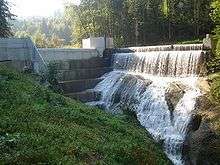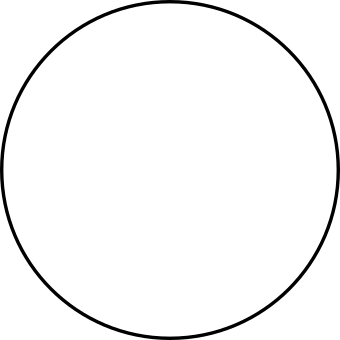Electricity sector in Switzerland
The electricity sector in Switzerland relies mainly on hydroelectricity, since the Alps cover almost two-thirds of the country's land mass, providing many large mountain lakes and artificial reservoirs suited for hydro power. In addition, the water masses drained from the Swiss Alps are intensively used by run-of-the-river hydroelectricity (ROR). With 9,052 kWh per person in 2008, the country's electricity consumption is relatively high and was 22% above the European Union's average.

- Hydro–ROR: 17,759 GWh (26.8%)
- Hydro–Dam: 19,681 GWh (29.7%)
- Solar PV: 544 GWh (0.8%)
- Biogas: 284 GWh (0.4%)
- Wood: 277 GWh (0.4%)
- Wind: 89 GWh (0.1%)
- Waste Incin.: 1,050 GWh (1.6%)
- Nuclear: 24,861 GWh (37.6%)
- Fossil fuel: 1,634 GWh (2.5%)
In 2013, net generated electricity amounted to 66.2 terawatt-hours (TWh). About 60% of Switzerland's electricity generation comes from renewable sources, most of it from hydro (56.6%), while non-hydro renewables supplied a small contribution of 3.4%. Nuclear contributed 37.6% to the country's electricity production and only about 2.5% were generated by fossil fuel based thermal power stations.[1][2]
Consumption
According to IEA the electricity use (gross production + imports – exports – transmission/distribution losses) in Switzerland was in 2004 60.6 TWh, (2007) 61.6 TWh and (2008) 63.5 TWh.[3] In 2008 Switzerland consumed electricity per inhabitant 122% compared to the European Union 15 average (9,052 / EU15: 7,409 electricity use per inhabitant 2008, kWh/person) [4] and 133% compared to the United Kingdom (2008: UK 372.19 TWh per 59.9milj. person and Switzerland 63,53 TWh per 7,71 milj.person).[3]
Hydro power
Hydroelectricity is by far the country's most important source of energy, and contributing more than half to its electricity generation. Hydro power is generally divided into conventional hydroelectricity (using a dam) and run-of-the-river hydroelectricity. In addition, pumped-storage hydroelectricity (PHS) plays an important role in Switzerland, being used in combination with base load power plants and to green-washing nuclear power from France.
Small hydro
The KEV remuneration (see below) also applies to small-scale hydro power plants with nameplate capacities up to 10 megawatts.
Nuclear power
There are four nuclear power plants, with a total of five operational reactors. In 2013, they produced 24.8 terawatt-hours (TWh) of electricity. Nuclear power accounted for 36.4% of the nation's gross electricity generation of 68.3 TWh[5] In addition, there are a number of research reactors in Switzerland, one of them at the EPFL.
In 2011, the federal authorities decided to gradually phase out nuclear power in Switzerland as a consequence of the Fukushima accident in Japan. In late 2013 the operator BKW decided to cease all electrical generation in 2019 in the Mühleberg plant
As of December 8, 2014, the National Council has voted to limit the operational life-time of the Beznau Nuclear Power Plant—which houses the oldest commercial reactor of the world—to 60 years, forcing decommissioning upon its two reactors by 2029 and 2031, respectively.[6]
Non-hydro renewables
Feed-in remuneration at cost (KEV)
The federal government adopted feed-in tariffs to offer a cost-based compensation to renewable energy producers. The feed-in remuneration at cost (KEV, German: Kostendeckende Einspeisevergütung, French: Rétribution à prix coûtant du courant injecté, Italian: Rimunerazione a copertura dei costi per l'immissione in rete di energia elettrica) is the primary instrument for promoting the deployment of power systems using renewable energy sources.
It covers the difference between the production and the market price, and guarantees producers of electricity from renewable sources a price that corresponds to their production costs. The following renewable energy sources are supported by the KEV remuneration: distributed small hydro (with capacities up to 10 MW), solar photovoltaics, wind power, geothermal energy, biomass and biogas (from agriculture, waste and water treatment).
The KEV remuneration is financed by collecting a surcharge on the consumed kilowatt-hour of electricity. As in other countries, industries with a large electricity consumption are exempt from the surcharge, which has gradually been increased and stands at 1.5 cents per kWh as of 2014.[7]
The remuneration tariffs for renewables have been specified based on reference power plants for each individual technology. Feed-in tariffs are applicable for 20 to 25 years, depending on the technology. In view of the anticipated technological progress and the increasing degree of market maturity of renewables energy technologies (especially for solar PV), the feed-in tariffs are subjected to a gradual reduction once or twice a year. These reductions only apply to new production facilities that are put into operation.
Planned installations of renewable power facilities have to be registered with Swissgrid, the national network operator. As of the end of 2014, a growing waiting list for solar photovoltaic systems has accumulated as demand excess the capped capacities given by the currently available funds of the KEV remuneration.
Wind power
Swiss wind power accounted for only 89 GWh or 0.1% of net-electricity production in 2013.
Solar power
For many years, Switzerland's pace of deploying solar PV had been lagging significantly behind its neighboring Germany and Italy. However, installed capacity of solar PV increased by 300 MW or 69% to 737 MW in 2013 and is likely to continue its strong growth due to the recently ramped up KEV funds. In 2014, another installed 320 MW brought the country beyond the gigawatt mark and the IEA-PVPS estimates the now installed capacity sufficient to supply close to 2% of the domestic electricity demands.[8]
Geothermal power
An induced seismicity in Basel led the city to suspend a geothermal energy project and conduct a seismic hazard evaluation, which resulted in its cancellation in December 2009.[9]
Global warming
Emissions of carbon dioxide in total, per capita in 2007 were 5.6 tons CO2 compared to EU 27 average 7.9 tons CO2.[10]
Carbon dioxide emissions
A study published in 2009 showed that the emissions of carbon dioxide (CO
2) due to the electricity consumed in Switzerland (total: 5.7 million tonnes) are seven times higher than the emissions of carbon dioxide due to the electricity produced in Switzerland (total: 0.8 million tonnes).[11]
The study also show that the production in Switzerland (64.6 TWh) is similar to the amount of electricity consumed in the country (63.7 TWh).[11] Overall, Switzerland exports 7.6 TWh and imports 6.8 TWh; but, in terms of emissions of carbon dioxide, Switzerland exports "clean" electricity causing emissions of 0.1 million tonnes of CO
2 and imports "dirty" electricity causing emissions of 5 million tonnes of CO
2.[11]
The electricity produced in Switzerland generated 14 grammes of CO
2 per kilowatt hour. The electricity consumed in Switzerland generated 100 grammes of CO
2 per kilowatt hour.[12]
Power stations
In Switzerland, there also exists a single-phase AC grid operated with 16.7 Hz for power supply of railway lines, see List of installations for 15 kV AC railway electrification in Germany, Austria and Switzerland.
Notes and references
- Swiss Federal Office of Energy SFOE, Schweizerische Statistik der erneuerbaren Energien 2013 Archived 2017-07-29 at the Wayback Machine, p. 2 and 6, 25 September 2014
- Swiss Federal Office of Energy (SFOE) Electricity statistics 2013 (in French and German) Archived 2014-12-18 at the Wayback Machine, p. 2 and 3, 23 June 2014
- IEA Key stats 2010 page 56
- Energy in Sweden 2010, table: Specific electricity production per inhabitant with breakdown by power source Table 49 Archived October 16, 2013, at the Wayback Machine.
- Swiss Federal Office of Energy (SFOE) Electricity statistics 2013 (in French and German) Archived 2014-12-18 at the Wayback Machine, 23 June 2014
- "Archived copy". Archived from the original on 2012-10-24. Retrieved 2012-10-25.CS1 maint: archived copy as title (link), Neue Zürcher Zeitung, ["Archived copy". Archived from the original on 2012-10-24. Retrieved 2012-10-25.CS1 maint: archived copy as title (link)schweiz/nationalrat-will-beznau-nach-60-jahren-vom-netz-nehmen-1.18440712 Nationalrat will Beznau nach 60 Jahren vom Netz nehmen (in German)], 8 December 2014
- Die Neue Zürcher Zeitung, (in German), 20 August 2014
-
"Snapshot of Global PV 1992-2014" (PDF). http://www.iea-pvps.org/index.php?id=32. International Energy Agency — Photovoltaic Power Systems Programme. 30 March 2015. p. 13. Archived from the original on 30 March 2015. External link in
|website=(help) - Glanz, James (2009-12-10), "Quake Threat Leads Swiss to Close Geothermal Project", The New York Times
- Energy in Sweden 2010, Table 1: Emissions of carbon dioxide in total, per capita and per GDP in EU and OECD countries, 2007 2010 Table 1 Archived October 16, 2013, at the Wayback Machine
- (in French) TEP Energy GmbH, "Intensité CO
2 de l’électricité vendue aux consommateurs finaux en Suisse", 17 July 2009 (page visited on 6 October 2013). - (in French) Isabelle Chevalley, "D’où vient l’électricité que vous consommez ?", Le Temps, 7 October 2009 (page visited on 6 October 2013).

